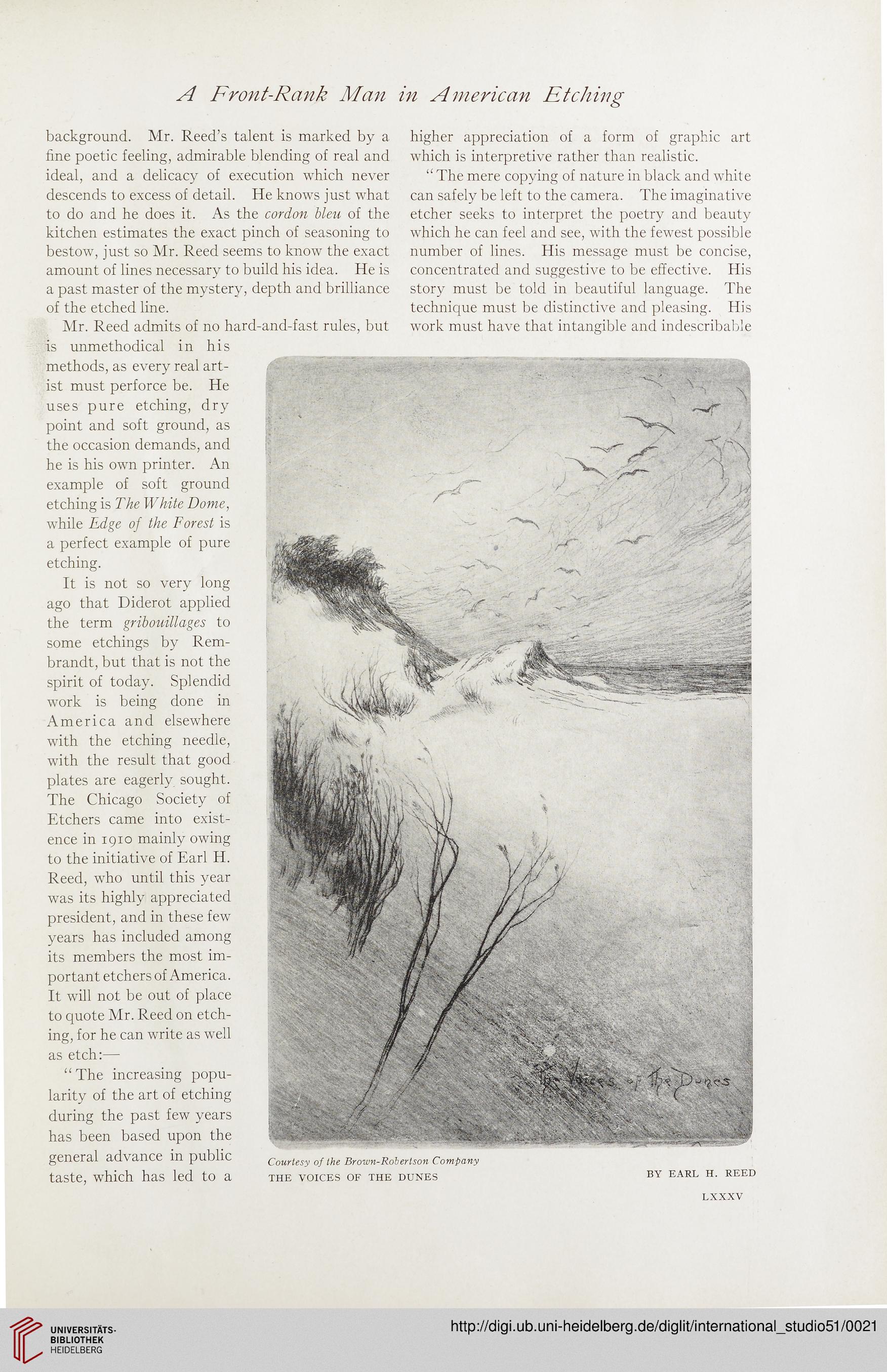A Front-Rank Man in American Etching
Wi EARL H. REED
Courtesy of the Brown-Robertson Company
THE VOICES OF THE DUNES
background. Mr. Reed’s talent is marked by a
fine poetic feeling, admirable blending of real and
ideal, and a delicacy of execution which never
descends to excess of detail. He knows just what
to do and he does it. As the cordon bleu of the
kitchen estimates the exact pinch of seasoning to
bestow, just so Mr. Reed seems to know the exact
amount of lines necessary to build his idea. He is
a past master of the mystery, depth and brilliance
of the etched line.
Mr. Reed admits of no hard-and-fast rules, but
is unmethodical in his
methods, as every real art¬
ist must perforce be. He
uses pure etching, dry
point and soft ground, as
the occasion demands, and
he is his own printer. An
example of soft ground
etching is The White Dome,
while Edge of the Forest is
a perfect example of pure
etching.
It is not so very long
ago that Diderot applied
the term gribouillages to
some etchings by Rem¬
brandt, but that is not the
spirit of today. Splendid
work is being done in
America and elsewhere
with the etching needle,
with the result that good
plates are eagerly sought.
The Chicago Society of
Etchers came into exist¬
ence in 1910 mainly owing
to the initiative of Earl H.
Reed, who until this year
was its highly appreciated
president, and in these few
years has included among
its members the most im¬
portant etchers of America.
It will not be out of place
to quote Mr. Reed on etch¬
ing, for he can write as well
as etch:—
“The increasing popu¬
larity of the art of etching
during the past few years
has been based upon the
general advance in public
taste, which has led to a
higher appreciation of a form of graphic art
which is interpretive rather than realistic.
“ The mere copying of nature in black and white
can safely be left to the camera. The imaginative
etcher seeks to interpret the poetry and beauty
which he can feel and see, with the fewest possible
number of lines. His message must be concise,
concentrated and suggestive to be effective. His
story must be told in beautiful language. The
technique must be distinctive and pleasing. His
work must have that intangible and indescribable
LXXXV
Wi EARL H. REED
Courtesy of the Brown-Robertson Company
THE VOICES OF THE DUNES
background. Mr. Reed’s talent is marked by a
fine poetic feeling, admirable blending of real and
ideal, and a delicacy of execution which never
descends to excess of detail. He knows just what
to do and he does it. As the cordon bleu of the
kitchen estimates the exact pinch of seasoning to
bestow, just so Mr. Reed seems to know the exact
amount of lines necessary to build his idea. He is
a past master of the mystery, depth and brilliance
of the etched line.
Mr. Reed admits of no hard-and-fast rules, but
is unmethodical in his
methods, as every real art¬
ist must perforce be. He
uses pure etching, dry
point and soft ground, as
the occasion demands, and
he is his own printer. An
example of soft ground
etching is The White Dome,
while Edge of the Forest is
a perfect example of pure
etching.
It is not so very long
ago that Diderot applied
the term gribouillages to
some etchings by Rem¬
brandt, but that is not the
spirit of today. Splendid
work is being done in
America and elsewhere
with the etching needle,
with the result that good
plates are eagerly sought.
The Chicago Society of
Etchers came into exist¬
ence in 1910 mainly owing
to the initiative of Earl H.
Reed, who until this year
was its highly appreciated
president, and in these few
years has included among
its members the most im¬
portant etchers of America.
It will not be out of place
to quote Mr. Reed on etch¬
ing, for he can write as well
as etch:—
“The increasing popu¬
larity of the art of etching
during the past few years
has been based upon the
general advance in public
taste, which has led to a
higher appreciation of a form of graphic art
which is interpretive rather than realistic.
“ The mere copying of nature in black and white
can safely be left to the camera. The imaginative
etcher seeks to interpret the poetry and beauty
which he can feel and see, with the fewest possible
number of lines. His message must be concise,
concentrated and suggestive to be effective. His
story must be told in beautiful language. The
technique must be distinctive and pleasing. His
work must have that intangible and indescribable
LXXXV




